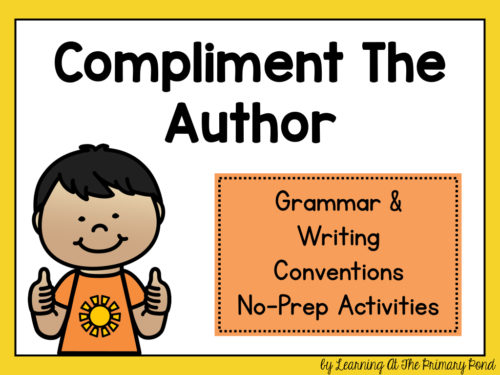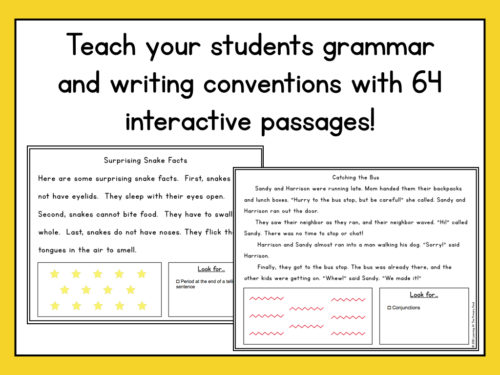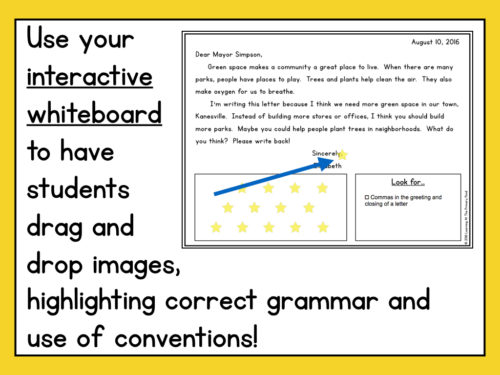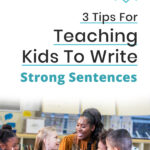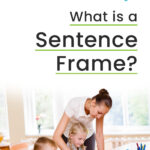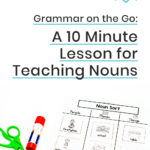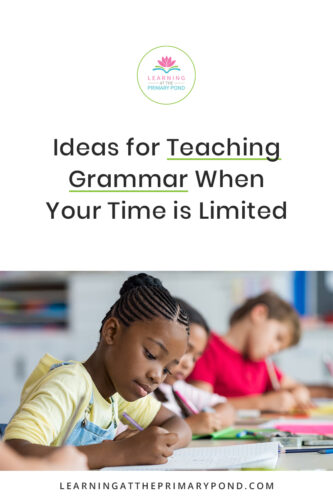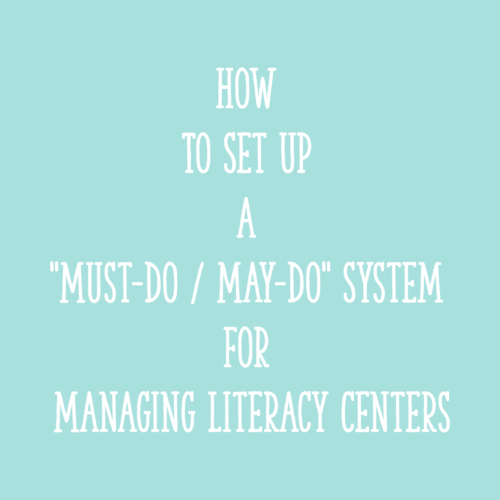When our students grow up, we hope that they will become fully-functioning members of the workplace and society. We want them to be able to create well-written emails, write clear letters and memos, give directions through writing, and so on.
In other words, we want our students to be able to use their knowledge of grammar and writing conventions to…well, write!
So when we teach those grammar and conventions skills, we need to keep our end goals in mind.
In their future lives, our students are not going to arrive at work in the morning and begin fixing incorrectly written sentences (D.O.L., anyone?). Their supervisors aren’t going to hand them grammar worksheets to complete before noon. Therefore, I don’t think we should limit our grammar instruction to those types of activities.
Furthermore, a significant body of research indicates that these types of sentence-fixing exercises aren’t effective, anyway. There are always exceptions, but sentence-fixing activities typically don’t have an impact on students’ writing (Ruday, 2013).
I’ve seen this firsthand, too – some of my kiddos who are the most eager and successful participants in sentence fixing activities are just NOT able to apply those skills to their own writing.
So again, keeping our goals in mind – if we are teaching grammar and conventions for the purpose of improving the quality of students’ writing, then the instructional activities we choose need to be closely linked to those intended outcomes.
That’s not to say that brief grammar exercises, activities, and games don’t have value. They definitely do! But I believe that the majority of our grammar instruction should take place in the context of real writing.
My preference, as a K-2 teacher and literacy specialist, is to teach grammar and conventions during writing workshop.
I then supplement some lessons with a little morning work or a follow-up activity designed to reinforce what I’ve taught and give students more practice. But I don’t schedule in 20 minutes of grammar every day.
(By the way, if you do have a daily grammar block and use sentence fixing activities – no judgment here. I’m just sharing what works best for me. I think it’s wrong to make fun of or shame teachers for their use of instructional practices. We are all learning, all the time. That’s why I love being an educator!)
Anyway, in today’s post, I’m going to share some practical tips to help you integrate grammar instruction into your writing workshop!
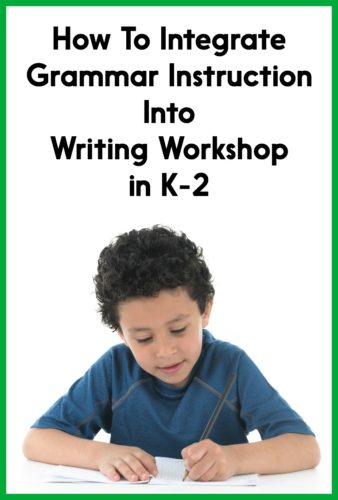
Photo Credit, MidoSemsem, Shutterstock
Spiraling Instruction
I don’t know about you, but the first time I teach something, some of my kids don’t get it! And another group of kids may understand it during the lesson, but they can’t necessarily apply it to their own work.
For this reason, I very carefully spiral my grammar/conventions instruction throughout the school year.
I teach writing through genre-based units. And in each one of those units, I plan specific minilessons on topics like punctuation or adjectives. I try to fit in 1-2 lessons during the unit, and then a couple more lessons at the end of the unit, when we are editing.
I teach certain skills in nearly all of my units. These include:
- Basic capitalization (first letter in a sentence, “I”)
- Punctuation (skills vary by grade level)
- Spelling strategies
Then, I plan to teach additional skills during the units in which they fit best. For example, a how-to writing unit is a fantastic time to teach students to use commas in a list. When we are teaching the reader how to do something, we often include a list of supplies (i.e. You will need tape, scissors, glue, and construction paper). Here are some other skills and ideas for teaching them:
- Capitalizing words in the date or using commas in the date (personal narratives – telling when something happened; opinion/persuasive writing – including the date in a letter)
- Capitalizing names of people (personal narrative or narrative writing – for telling characters’ names)
- Capitalizing the names of holidays (personal narratives – holidays and special celebrations present great opportunities for “small moments” stories; opinion/persuasive writing – writing about a favorite holiday; informational writing – providing information about a holiday)
- Capitalizing product names (opinion/persuasive writing – kids love to share ideas about their favorite foods, toys, etc., and these usually require including product names)
- Capitalizing geographic names (personal narratives or narratives – for describing the setting; informational writing – for telling where an animal lives, giving information about a region, etc.)
- Nouns (just about anything!)
- Verbs (personal narratives or narratives – I like to have kids find the verbs in their writing and then see if they can make them more powerful or interesting!)
- Adjectives (personal narratives/narratives – for describing characters, setting, etc.; opinion/persuasive writing – for choosing strong words to describe something and convince the reader; informational writing – for giving more details about an animal, place, sport, etc.)
- Proper nouns (again, just about anything – I like to teach these when I’m teaching a skill like capitalizing names of people, places, or product names)
Contextualized Lessons
So what does one of these lessons look like? Well, it depends. But I always try to help students see the connection between what we’re doing and their own writing.
Sometimes I’ll take out a text we’ve written as a class, or one I’ve modeled writing during previous minilessons. I’ll point out a convention I used, and we’ll talk about why I used it.
Other times, I’ll take out a text I’m working on (or occasionally start a new text), and think aloud while I model how to use the convention correctly.
Mentor texts are another great way to introduce the skill: “Writers, today I want to show you how one author uses commas to show us where to pause.” The document camera is a fabulous tool for zooming in on a text and getting kids to talk about what they notice, and how a certain convention helps us as readers.
When I’m using a mentor text during a writing minilesson, I always try to use a text that I’ve recently read aloud to kids. This allows us to focus on the convention (or whatever skill I’m teaching), since they have already had a chance to read or listen to the text for comprehension.
Then, I try to incorporate some kind of opportunity for guided practice.
We may write a sentence or two as a class, using the skill we just talked about. We may fix up some sentences from a piece of writing, using what we’ve learned about conventions. Or, I may have students grab a piece of finished or almost-finished writing and look for places where they might use the convention or add it in.(“Writers, I wonder if there are any proper nouns in your writing that need capital letters. Grab a partner, take out a finished or almost-finished piece of writing, and start taking a look.”) They get support from me and/or writing partners when we do an activity like this.
Last, I want them to be able to apply this independently, to their own writing. This takes time! But we get there through individual or small group writing conferences, future lessons, and other opportunities to try out the skill in their own writing.
Conclusions
Learning grammar and conventions is part of learning to write. I’ve been able to integrate grammar instruction into writing workshop by carefully mapping out when I will teach these lessons throughout the year.
If you’re looking for a quick and easy way to show students examples of correct grammar and writing conventions usage in context, check out my interactive “Compliment The Author” passages! They’re designed for an interactive white board (SmartBoard, Promethean, ActivInspire) – students can drag and drop objects to highlight where the author (aka me 😉 ) used a convention correctly. Click on any image below to learn more!
Do you have any special grammar strategies that have worked well for you? Please share in the comments below – I’d love to hear from you!
References:
Graham, S., MacArthur, C. A., & Fitzgerald, J. (Eds.). (2007). Best Practices in Writing Instruction. New York, NY: The Guilford Press.
Morrow, L. M., & Gambrell, L. B. (Eds.). (2011). Best Practices in Literacy Instruction (4th ed.). New York, NY: The Guilford Press.
Ruday, S. (2013). Five Recommendations for Teaching Common Core Grammar to Elementary Students. Larchmont, NY: Eye on Education.

